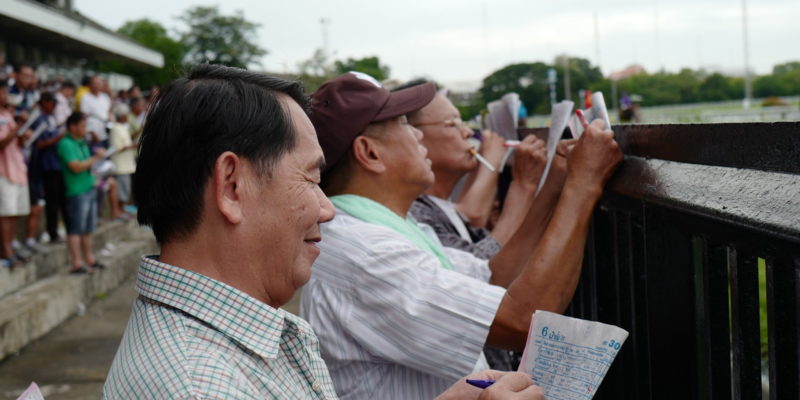Finish Line for Century-Old Bangkok Horse Track/Duncan McCargo

Thousands of people gather here at weekends in the heart of Bangkok, but there are no farang backpackers, no Japanese expats and not even any Chinese tourists. Nobody takes selfies, and nobody is checking Facebook on their phones. There’s not a latte in sight: the fanciest restaurant in the joint still serves only Nescafé. Ninety percent of the customers are male, and most are over 60. They spend the afternoon nerdily poring over badly printed programmes, occasionally scanning the horizon with rented binoculars.
I appear to have passed through a time warp and stepped out in 1972. Either that, or I am on the set of an old Thai movie.
Most seem to have dressed down for the occasion. Smoking rates have temporarily reverted to pre-health warning levels, and the gender roles reflect a bygone era: I appear to have passed through a time warp and stepped out in 1972. Either that, or I am on the set of an old Thai movie.
I am in fact visiting the Sanam Thai, or the Nang Leong racecourse – officially known in English as the Royal Bangkok Turf Club Under Royal Patronage – which occupies an improbably expansive island of green in the heart of the capital’s historic Dusit district, wedged between Chitralada Palace and Ban Phitsanulok, the official residence of the prime minister.
Founded in 1916 under the patronage of King Vajiravudh (Rama VI), the Club has an illustrious and venerable history. A life-sized statue of King Vajiravudh’s horse stands expectantly in the lobby of the run-down clubhouse, looking as though it might bolt through the doors at any moment.
The Sanam Thai has long been intimately involved with politics. The current president is former prime minister, now privy councilor, General Surayud Chulanont; the racecourse is closely associated with the Royal Thai Army. A national general assembly was held here following the upheavals and violence of 14 October 1973, to prepare for the drafting of a new constitution. In October 2012, then Club Secretary General Boonlert Kaewprasit, better known as ‘Seh Ai’, rallied 20,000 supporters of his Pitak Siam group at the race course, in a failed early attempt to topple the Yingluck Shinawatra government that was eventually overthrown by the military in May 2014.
A national general assembly was held here following the upheavals and violence of 14 October 1973, to prepare for the drafting of a new constitution
This past April, the Crown Property Bureau ordered the racecourse to clear out – Nang Leong’s lease actually expired 19 years ago – and the Royal Turf Club will be closing its gates for the last time in September. Some families have lived and worked there – and at the co-located Royal Dusit Golf Course – for generations. Many have no idea what the future holds for them. And while there has been talk of a public park, a hospital or even a museum, the Bureau’s plans for the spectacular 79-acre site remain unclear. Still, the Club’s eviction is a none-too-subtle reminder that even during a period of military rule, the prestige and privileges of the Royal Thai Army are not untouchable.
Racing, however, will continue on two Sundays a month at the Royal Bangkok Sports Club in Bangkok’s Phatumwan district: the Sanam Farang, or 'foreigners' course.' The Turf Club was originally set up as a breakaway from the Sports Club by Siamese aristocrats who were unhappy with the domination of horse-racing by European expatriates, but history has come full circle.
Last Sunday, it was hard to believe that after 102 years, racing at the Sanam Thai would soon end. In the stable areas, jockeys waited with varying degrees of patience, their lined faces revealing that this is not a young man’s sport.
Jittery horses were calmed, hosed down, dried off, and walked around in iterative circles. Many of the racehorses had come from Korat and other distant provinces. Both riders and steeds had been here before: most looked jaded and subdued before the races, yet here and there a horse or a man had a glint in the eye, a spark of triumph, of potential glory.
In the cheap and cheer-filled 50 baht (US$1.50) stands, middle-aged male excitement was palpable – and extremely audible – during each of the afternoon’s ten 1,200 metre races, each lasting just over a minute. Hearts were fluttering over fancied horses, not to mention all the small-ish bets these gentlemen had staked at the numerous legal gambling terminals. One seasoned punter told me he had won 7,000 baht on the previous race, but sheepishly admitted that he usually lost. He’d been coming to the track for 51 years, half of the Turf Club’s lifetime.
One seasoned punter told me he had won 7,000 baht on the previous race, but sheepishly admitted that he usually lost. He’d been coming to the track for 51 years, half of the Turf Club’s lifetime.
I then passed through the privileged portals of the VIP section, reserved for Club members, plus anyone else willing to spend 1,000 baht for a ticket that includes lunch. The members’ terrace is right at the finish line. As the brightly-attired jockeys flew past on their sleek mounts just inches from my face, for the first and perhaps the last time I felt hopelessly thrilled by the sport of kings.
During the warm-up before the last race, as the sun began to go down and wide-winged cranes circled slowly above the course, one temperamental horse hurled his jockey onto the turf right in front of me. Unabashed, the diminutive rider dusted himself off and began walking towards the starting stalls for one of the storied track’s final runs.
First published in Asia Times, 12 August 2018
Photographs © Duncan McCargo 2022
